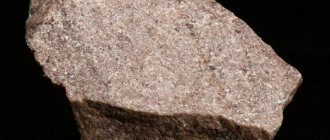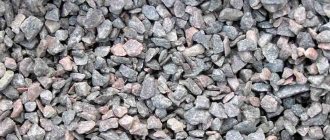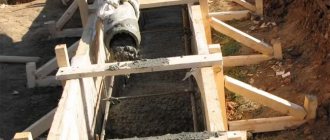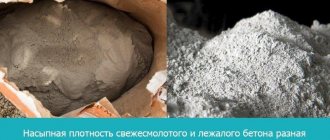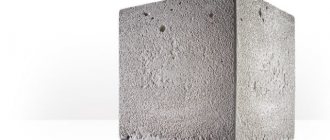In individual construction, the preparation of cement or concrete mortar becomes especially important - in order to obtain high-quality concrete, it is necessary to strictly observe the proportions, characteristics of the materials and the technology for preparing the mixture. Improper mixing means rapid destruction of the structure, which means the unreliability of the house or outbuildings. Therefore, you need to know exactly in what proportions for 1 cubic meter concrete and sand must be added, and how these proportions affect the grade of concrete and the quality of the solution.
Proportions of components when preparing the solution
Step-by-step instructions for making concrete by hand
Nowadays, concrete mixers are most often used for concreting. But not all developers yet work with technology, especially if they need to quickly prepare a small amount of concrete for urgent repairs. The mass is stirred with a shovel or hoe in a special trough. If you don’t have it, then you can make concrete on a hard, level area; large sheets of thick iron are often used for this purpose. Mixing is much simpler and easier with a hoe; attach a long handle to it so that you can reach from one place throughout the entire trough.
Trough and hoe for mixing concrete manually
Step 1. Fill a container with dry cement, pour in water and mix everything very thoroughly. Your task is to turn the composition into the consistency of milk. A bucket of cement requires about half a bucket of water. Below we will describe in detail what causes this proportion.
Cement is poured into a dry trough, then water is poured in.
Step 2. Mix the composition thoroughly with a hoe.
Cement and water must be mixed until the lumps dissolve
In such a container you can prepare a composition from one bucket of cement, three buckets of sand and the same amount of crushed stone. There is no need to do more at one time - it is very difficult to mix increased volumes of concrete. It's much easier to make two small batches than one big one. In addition, the quality is also much better, the positive effect is achieved through more thorough mixing.
Step 3. Pour crushed stone into the trough. It will completely break up the remaining small lumps of cement. You can pour all three buckets of material at once; it is advisable to distribute it evenly over the entire area of the container.
Crushed stone can be added immediately in full
Step 4: Start mixing. This is already somewhat more difficult than working with cement alone.
Stirring with crushed stone will require more physical effort
Step 5. Add three buckets of sand to the container. In our case, sand and crushed stone are poured into bags, each containing three buckets, as required by the recipe. Mix the sand, this is the most difficult operation and requires quite a lot of effort and time. The hoe should slide along the bottom of the trough and across the entire area.
After adding sand, you need to stir very thoroughly.
Depending on the actual consistency, add water or sand; we have already described how this is done and what you need to pay attention to. Prepare as much mixture as you can use within thirty minutes
After this time, the rates of chemical reactions of cement critically increase. Concrete hardens; adding water to it is strictly not recommended; as a result of such actions, the material significantly worsens its strength parameters.
Ready concrete must be used within half an hour
Simple concrete mixing
If you are not striving for factory accuracy, and the grade of concrete is not so important, then there is a very simple way to hammer it. To do this, take 1 part cement, half part water, 2 parts coarse sand and 4 parts crushed stone.
To make 1 cubic meter of concrete using this method, you will need 330 kilograms of cement, 180 liters of water, 600 kilograms of sand and 1250 kilograms of crushed stone.
The quality of the resulting concrete mixture will depend on the order in which you add the above components into the concrete mixer.
Calculation of concrete mixture composition
The classification of concrete is based on compressive strength. In accordance with the requirements of SNiP2.03.01-84 “Concrete and reinforced concrete structures”, the marking of concrete on concrete structures, as well as from a mixture of sand and crushed stone, contains the letter “B” and numbers indicating the load in MPa. This is a relatively new designation.
The more familiar marking with the letter “M” and strength, measured in kg/cm2, has not lost its relevance. By the way, cement is marked in exactly the same way. Concrete grades from M100 to M 500 are used in construction.
The strength, density and other characteristics of the final product are affected by the ratio of cement and the proportion of PGS in concrete, as well as the content of aggregates made from grains of different sizes in the mixture. The following grades of concrete are used for certain purposes:
- M 150 – it is recommended to prepare for the construction of foundations for light buildings of one floor;
- M 200 – used in the construction of strip and low-power slab foundations;
- M 250 – for foundations in the form of a monolithic slab for medium loads;
- M 300 – for monolithic foundations of any design;
- M 400 - with high-quality cement, used for the construction of especially powerful foundations under heavy loads.
For the convenience of calculating material consumption, we will combine the proportions of pgs and cement for concrete of different grades into a table.
| Concrete grade | Consumption of OPGS per 1 kg of Portland cement, kg | Consumption of OPGS per 10 liters of Portland cement, l | Amount of concrete produced from 10 liters of cement, l | |||
| M 400 | M 500 | M400 | M500 | M400 | M500 | |
| 100 | 11,6 | 13,9 | 102 | 124 | 78 | 90 |
| 150 | 9,2 | 11,1 | 82 | 98 | 64 | 73 |
| 200 | 7,6 | 9,1 | 67 | 81 | 54 | 62 |
| 250 | 6,0 | 7,1 | 53 | 63 | 43 | 50 |
| 300 | 5,6 | 6,7 | 49 | 59 | 41 | 47 |
| 400 | 3,9 | 4,8 | 35 | 42 | 31 | 36 |
| 500 | 3,6 | 4,3 | 32 | 37 | 29 | 32 |
According to the table, you can understand that from 10 liters of M400 cement you can get 41 liters of M 300 concrete. If you measure proportions in buckets, then to prepare concrete you need to measure out one bucket of cement and almost 7 buckets of sand and gravel mixture.
Using the available proportions, you can easily calculate the need for materials to prepare 1 m3 of concrete. Let's make simple equations:
- You will need M400 cement: 1000 * 10:41 = 244 liters or 24.5 buckets.
- ASG for 1 cubic meter of concrete should be taken: 1000 * 49:41 = 1195 liters or 119.5 buckets.
Construction of various structures
The purpose of the mixture also determines how much Portland cement is required per 1 cubic meter of solution.
For various operations, there are formulas and standards that allow you to find out the correct ratio of components. By focusing on them, you will be sure that the work was done efficiently and that unnecessary costs were avoided. To erect structures that will have to experience high loads, you need a strong mortar that, after hardening, creates a particularly strong monolith of grade M300 and higher. But finishing, such as making horizontal screed or plaster, on the contrary, will require greater mobility from the mixture, but not too high strength from M100 to M150. The production of products like cinder blocks even allows the use of the M50 brand.
1. Bricklaying.
The cement-sand mixture for such work is produced without coarse aggregate - the building blocks themselves do an excellent job of fulfilling its role. And the task of the solution is to securely fasten them together. To determine how much cement is needed per cubic meter of masonry mortar, you can use the traditional volume ratio. Just one thing to consider:
Standard proportions are prepared in two versions:
- 1:3 – binder content – 33% of the cube or 0.333 m3;
- 1:4 – 1 cubic meter will require 0.25 m3 of Portland cement.
It is customary to give proportions in units of volume, but you have to buy components for them by weight. Knowing the bulk density of materials will help convert the volume into kilograms. And the total consumption for masonry is calculated based on the fact that a cubic meter of mixture is used for 4-5 m3 of a brick wall.
To determine how many bags of cement you need per cubic meter in your case, you can use a simple calculation. Let's take a CP ratio of 1:4, that is, the binder in a cubic meter will take up a quarter (250 l). The density of cement is taken to be about 1.4 kg/l. Then in a cube of volume its weight will be 1.4 · 250 = 350 kg. The standard packaging of bags is 50 kg, that is, you need to buy 7 packages of building materials for each cubic meter of masonry.
2. Screed.
It is more convenient to calculate the screed solution for the entire volume of work at once. To do this, you only need to know the pouring area and the leveling height of the floor. Let's say you need to make a 6x6 screed with a thickness of 5 cm - this is 1.8 m3 of solution:
- The proportion of the CPU mixture for such work is taken to be 1:3.
- The volume of cement, respectively, is 1.8 / 3 = 0.6 cubic meters.
- Binder consumption: 0.6 × 1400 = 840 kg or 17 bags of 50 kg.
According to building codes, M500 screed will require 460 kg per cubic meter, M400 – 575 kg/m3. Our calculation showed a consumption of 467 kg/m3, which corresponds to SNiP.
3. Construction of the foundation.
Indicative data for pouring foundations for buildings with different grades of concrete can also be found in SNiP. But the solution for the foundation requires extreme accuracy in calculations, since deviations will lead to loss of the bearing capacity of the foundation and a decrease in the service life of the entire building.
Mixtures of different brands
The brand of concrete, as well as the brand of cement for its production, is selected at the design stage of the building. Here everything depends on the loads exerting pressure on the structure, since they will determine the required strength characteristics of the concrete.
To simplify calculations, standard proportions for solutions of different brands have already been developed by specialists. Using the table below, you can determine how many dry components are required per cubic meter:
| Concrete grade | Consumption of different grades of cement, kg per 1 m3 | ||
| M300 | M400 | M500 | |
| M50 | 310 | 230 | — |
| M100 | 390 | 300 | 250 |
| M150 | 510 | 400 | 300 |
| M200 | — | 490 | 410 |
| M300 | — | 600 | 510 |
| M400 | — | — |
Despite the strict requirements of building codes, cement consumption for building a foundation or performing other construction work sometimes has to be increased. This happens when one of the components is not of the best quality or simply does not correspond to the design data. The solution to the current situation at the construction site is the same - increase cement consumption:
Materials calculation: without reinventing the wheel
How to calculate cement for the foundation? For the accuracy of the results, it is necessary to take into account the grades of concrete and cement, as well as the ratio of water and cement, which is called briefly - VC. The table below is visual and does not require a person to have a degree in mathematics.
The table is easy to use. For example, we need to prepare 2 m3 of M250 concrete:
- It requires M500 cement, which means we multiply 297 kg by 2 and get 594 kg. Now this number must be divided by 50, since this is the weight of one bag of cement: 594/50 = 11.88. We round the result towards a larger value - we get 12 bags of M500 cement.
- Crushed stone with a grain size of 20 mm for our concrete will be calculated as follows: 1188 multiplied by 2, we get 2376 kg. If you choose a different faction, then all calculations will have to be done again.
- Sand is calculated in the same way as crushed stone: 1188 * 2 = 2376 kg.
- We find water like this: multiply 205 liters by 2, resulting in 410 liters.
Indeed, calculations should not cause difficulties; you just need to decide on the required characteristics of your raw materials. If plasticizers are used for the foundation, then adjustments must be made to the calculations; the coefficients can easily be found in reference books.
How to calculate correctly
The initial mixtures of components may have different percentages of moisture, and excess water leads to the fact that the ratio of crushed stone, sand and cement for concrete is built incorrectly due to an increase in the weight of the components if the calculation is carried out by weight. Therefore, it is always preferable to make calculations by volume.
There are several advantages to this:
- It is more convenient to calculate how much ASG and cement are needed to fill a specific structure, the volume of which can also be easily calculated.
- Violations in the ratio of components are excluded if they are waterlogged.
- There are fewer problems in practice; it is easier to measure the volume of a bulk substance than its weight.
Features of calculating cement consumption per 1 cubic meter of concrete
Cement consumption per 1 m3 of concrete is reference information (when using M500 cement), which is displayed in the consumption table for the main grades of concrete:
| Concrete marking | Application | M500 cement consumption in kg per 1 cubic meter of concrete |
| M100 | Lightweight concrete used in the preparatory stages preceding concrete work | 166 |
| M200 | Concrete has a wide range of applications, most often used for pouring foundations | 241 |
| M300 | Concrete for a wide range of applications, characterized by good strength properties | 319 |
| M400 | Medium concrete, characterized by rapid hardening, is most often used in the construction of hydraulic structures. | 417 |
To obtain high-quality concrete that will ensure a long service life of the structure, it is important to use the components in the right proportion. The amount of cement affects the workability of concrete
Therefore, when preparing concrete, the accuracy of laying components must be observed in the following volumes:
The amount of cement affects the workability of concrete. Therefore, when preparing concrete, the accuracy of laying components must be observed in the following volumes:
- Cement - up to 1 kg.
- Sand - up to 3 kg.
- Crushed stone - up to 5 kg.
You can read more about these proportions in the article The ratio of crushed stone, sand and cement in concrete.
In this case, subject to the required proportions, high-quality concrete will be produced, that is:
- Lasting;
- With the necessary rigidity;
- Plastic.
If you make a large error, for example, in the direction of reducing the amount of cement, then the binding material will not hold the filler, which means that the concrete will become unusable in a short time under the influence of external negative factors.
The consumption of cement per 1 cubic meter of concrete depends on what brand of concrete mixture is planned to be produced. And this depends on what the concrete is planned to be used for. In domestic low-rise construction, the following are most often used:
- Concrete marked M200, characterized by high compressive strength. It is used in the construction of various types of foundations, pouring sites and forming paths. It is also often used in the construction of stairs and as a concrete pad when installing curbs.
- Concrete marked M300. It can be used for pouring monolithic foundations, but is most often used in the construction of walls and the formation of building floors.
The grade of cement used in the preparation of concrete is always 1.5 or 2 times higher than the grade of concrete prepared from it. So, for example, to prepare M200 concrete it is necessary to use cement marked M300 or M400.
For the convenience of preparing concrete, it is recommended to purchase cement in 50 kg bags. Using such a measuring device will allow you to easily prepare a concrete mixture. So, to produce 1 cube of the most popular concrete marked M200, you will need 4 bags and 41 kg of cement grade M300 or M400.
Preparation and proportions
For those wishing to prepare concrete themselves, we recommend using the tables. Although there are fairly simple formulas for calculating the composition, it is unlikely that anyone will use them - after all, not all people do construction every day. Therefore, a table of concrete proportions per 1 m³ will be very useful.
Tabular data
In the literature you can find various recommendations for calculating proportions. Some give them in mass fractions, others in volume fractions, but more often both are used. For example, here is a universal table:
| M concrete | M cement | crushed stone size, mm | cement, kg | cement, liters | sand, kg | sand, l | crushed stone, kg | crushed stone, l | water, l |
| 100 | 300 | 40 | 242,16 | 220,97 | 760 | 528 | 1132 | 839 | 208 |
| 100 | 300 | 20 | 257,3 | 234,09 | 760 | 704 | 1117 | 827 | 208 |
| 150 | 300 | 40 | 302,7 | 275,4 | 680 | 472 | 1211 | 816 | 211 |
| 150 | 300 | 20 | 322,88 | 293,62 | 671 | 465 | 1200 | 889 | 211 |
| 200 | 300 | 40 | 354,16 | 321,87 | 665 | 463 | 1173 | 869 | 205 |
| 200 | 300 | 20 | 378,38 | 344,07 | 640 | 444 | 1173 | 869 | 208 |
| 150 | 400 | 40 | 237,12 | 216,94 | 1165 | 532 | 1132 | 833 | 205 |
| 150 | 400 | 20 | 253,26 | 229,04 | 760 | 528 | 1123 | 831 | 208 |
| 200 | 400 | 40 | 282,52 | 257,3 | 751 | 521 | 1111 | 823 | 208 |
| 200 | 400 | 20 | 302,7 | 275,46 | 680 | 472 | 1211 | 896 | 211 |
| 300 | 400 | 40 | 414,7 | 376,36 | 655 | 455 | 1125 | 833 | 211 |
| 300 | 400 | 20 | 443,96 | 403,6 | 620 | 431 | 1131 | 837 | 211 |
| 150 | 500 | 40 | 201,8 | 176,58 | 811 | 563 | 1191 | 881 | 211 |
| 150 | 500 | 20 | 273,44 | 184,65 | 811 | 563 | 1180 | 881 | 200 |
| 200 | 500 | 40 | 247,21 | 214,92 | 755 | 524 | 1132 | 839 | 208 |
| 200 | 500 | 20 | 262,34 | 229,04 | 715 | 497 | 1175 | 871 | 211 |
| 300 | 500 | 40 | 383,42 | 333,98 | 660 | 459 | 1151 | 852 | 211 |
| 300 | 500 | 20 | 363,24 | 315,82 | 720 | 500 | 1111 | 889 | 211 |
| 400 | 500 | 40 | 438,92 | 382,41 | 625 | 435 | 1131 | 837 | 211 |
| 400 | 500 | 20 | 459,1 | 299,56 | 615 | 427 | 1115 | 827 | 211 |
Table 1 . Concrete, composition and proportions per 1 m³.
The table shows concrete with mobility grade P2, common in private housing construction. There are many options, as you can see above. Both the size of crushed stone and the grade of cement are taken into account. If the household has scales, then you can use them, but their absence is well compensated by buckets, the volume of which is 12 liters.
There are also more detailed tables from which you can calculate the proportions of the composition for a certain brand of mixture. For example, the composition of M300 concrete per 1 m³ in the table below is given depending on the degree of mobility:
| cone settlement (mobility), cm | cement M400 | crushed stone | sand | water |
| 1−2 | 335 | 1220 | 636 | 155 |
| 3−5 | 360 | 1202 | 630 | 165 |
| 6−8 | 380 | 1215 | 588 | 175 |
| 9−12 | 400 | 1200 | 560 | 185 |
Table 2 . The composition of M300 concrete has varying degrees of workability. All data is in kilograms.
You can often find proportions expressed in mass or volume fractions. The main thing here is to clarify whether we are talking about mass or volume, since only 1 liter of water weighs 1 kg. Here is an example of such a recommendation in shares:
| brand of cement | C, kg | P, kg | Shch, kg | C, l | P, l | Shch, l |
| M400 | 1 | 1.2 | 2.7 | 10 | 11 | 24 |
| M500 | 1 | 1.6 | 3.2 | 10 | 14 | 28 |
Table 3 . Concrete composition M400 per 1 m³.
The table, unfortunately, does not show how much water is required for kneading. But it gives a clear idea of how the brand of cement affects the required amount of aggregate. All data in the tables regarding aggregates is given for dry material. If the latter has moisture, then it must be taken into account when determining the amount of water.
Calculation of cement per 1 cubic meter of concrete (m³)
The proportional ratio of cement to other binding materials affects the mobility of the concrete mixture. In order to prepare high-quality building materials, the following ratios should be adhered to:
- cement up to 1 kg;
- sand up to 3 kg;
- crushed stone up to 5 kg.
Failure to comply with all component ratios leads to a decrease in the strength characteristics of the future building coating. This will lead to rapid wear and cracking of the surface. The quantitative consumption of cement per 1 m³ of solution directly depends on the brand of concrete mixture planned by the manufacturer. Under different climatic conditions and construction zones, different grades of material are used.
Concrete marking classifier
Table of the ratio of classes and grades of concrete.
For various requirements for the stability and reliability of a construction project, the following marking classifier of concrete mixtures is mainly used:
- M100. It is used at the initial (preparatory) stage of construction work.
- M200. Has a wider range of applications. Most often used when filling foundation surfaces.
- M300. This building material has great strength characteristics. The foundation laying with such a concrete monolith is used in industrial construction.
- M400. It is used in the construction of hydraulic structures. It has high strength and differs from other types of concrete by its rapid hardening.
Decoding of the building material: the letter M with a number that indicates the arithmetic mean value of the strength characteristics of the sample, for compression in kgf/cm².
How many cubes of concrete are needed for the foundation?
When constructing a civil or industrial facility, two types of foundation coverings are used: strip and slab foundations. For the convenience of calculation indicators, a reinforced concrete (reinforced concrete) foundation of 10 by 10 is taken:
- Strip foundation. The required amount of construction mixture is determined by the total volume of the base. The calculation is carried out by multiplying metric values: height, length and width of reinforced concrete tape. Initial data: height - 1.5 m, width - 0.5 m, total length of the tape - 55 m. Multiplying the values and rounding the value to a whole number, we get 41 cubic meters of concrete.
- Slab base. The amount of concrete mixture is determined very simply for a slab foundation. For example, the thickness of the slab is 40 cm. Multiplying the initial data, we get: 10 m x 10 m x 0.4 m = 40 m³.
Weight of 1 m³ of concrete mixture
The specific gravity of the binding building material is a variable value.
The mass of concrete weighs differently, depending on its structural components, that is, on the type of aggregate. In civil and industrial construction, a heavy type of concrete monolith is usually used. Gravel and crushed stone of large fractions are used as filler. Thanks to this base, the foundation coating has a particularly durable and stable surface. The weight of one cubic meter of concrete mixture ranges from 1.7 to 2.5 tons.
How much water is needed for the solution
When preparing concrete mortar, it is recommended to use only clean water - without chemical and organic impurities and dirt. It is quite difficult to calculate the preliminary required volume of water, since both the binder and the aggregates have different moisture content each time. The water absorption of cement also depends on its brand, therefore, how much water is needed to prepare the solution will become clear when preparing the mixture. To obtain one cubic meter of medium plasticity concrete with coarse crushed stone as filler, you will need about 205 liters of water.
[ads-pc-1] [ads-mob-3]
To prepare a high-quality concrete solution, you need to take only clean river or purified quarry sand, crushed stone of the calculated fraction without the presence of lamellar and needle-shaped grains, as well as fresh Portland cement. It is better to pre-rinse any crushed stone, even clean ones, and sift through a sieve with the calculated mesh sizes. It is also recommended to sift sand, regardless of its degree of purity.


